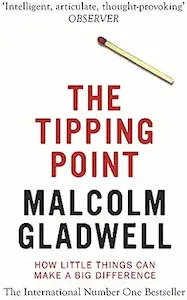Tipping Point - Summary
Malcolm Gladwell

Introduction
The Tipping Point by Malcolm Gladwell is a book that explores the concept of how ideas, products, and behaviors spread like viruses and become popular in society. The author argues that there is a point where a trend or idea reaches critical mass and suddenly becomes mainstream. Gladwell uses a variety of examples and anecdotes to illustrate his points, making the book both informative and engaging. In this essay, I will provide a summary of the book and highlight some of the key examples and anecdotes that Gladwell uses to support his arguments.
The Three Rules of Epidemics
Gladwell begins the book by introducing the three rules of epidemics. The first rule is the Law of the Few, which states that a small number of people are responsible for the majority of the spread of an idea or trend. These people are called connectors, mavens, and salesmen. Connectors are people who have a large social network and are able to introduce new ideas to a wide range of people. Mavens are people who have a deep knowledge of a particular subject and are able to influence others with their expertise. Salesmen are people who are persuasive and charismatic and are able to convince others to adopt a particular idea or trend.
The second rule is the Stickiness Factor, which refers to the ability of an idea or trend to stick in the minds of people. Gladwell uses the example of Sesame Street to illustrate this point. The creators of Sesame Street used a combination of music, humor, and repetition to make the show memorable and engaging for children.
The third rule is the Power of Context, which states that the environment and circumstances in which an idea or trend is introduced can have a significant impact on its success. Gladwell uses the example of the broken windows theory to illustrate this point. The theory suggests that if a broken window is left unrepaired, it sends a signal that no one cares about the area, which can lead to an increase in crime and disorder.
The Law of the Few
Gladwell devotes a significant portion of the book to exploring the Law of the Few. He argues that connectors, mavens, and salesmen are essential for the spread of ideas and trends. He uses the example of Paul Revere’s midnight ride to illustrate this point. Revere was a connector who was able to spread the word about the British invasion to a wide range of people, which helped to mobilize the colonial militia.
Gladwell also explores the concept of social epidemics, which are trends or ideas that spread rapidly through society. He uses the example of Hush Puppies, a brand of shoes that became popular in the 1990s. The brand was on the verge of bankruptcy when it suddenly became popular among hipsters in New York City. The trend then spread to other cities and eventually became mainstream.
The Stickiness Factor
The Stickiness Factor is another important concept that Gladwell explores in the book. He argues that ideas and trends need to be memorable and engaging in order to be successful. He uses the example of the children’s television show Blue’s Clues to illustrate this point. The creators of the show used a combination of music, repetition, and interactive elements to make the show engaging for children.
Gladwell also explores the concept of the “Broken Windows Theory” to illustrate the Stickiness Factor. The theory suggests that if a neighborhood is clean and well-maintained, it sends a signal that people care about the area, which can lead to a decrease in crime and disorder.
The Power of Context
The Power of Context is the final concept that Gladwell explores in the book. He argues that the environment and circumstances in which an idea or trend is introduced can have a significant impact on its success. He uses the example of the New York City subway system to illustrate this point. In the 1980s, the subway system was known for its crime and disorder. However, when the city implemented a series of changes, such as cleaning up graffiti and cracking down on fare evasion, crime rates on the subway system decreased dramatically.
Gladwell also explores the concept of the “Broken Windows Theory” to illustrate the Power of Context. The theory suggests that if a neighborhood is clean and well-maintained, it sends a signal that people care about the area, which can lead to a decrease in crime and disorder.
Conclusion
In conclusion, The Tipping Point by Malcolm Gladwell is a fascinating exploration of how ideas, products, and behaviors spread like viruses and become popular in society. Gladwell uses a variety of examples and anecdotes to illustrate his points, making the book both informative and engaging. The three rules of epidemics, the Law of the Few, the Stickiness Factor, and the Power of Context, are all essential concepts for understanding how trends and ideas become mainstream. Overall, The Tipping Point is a must-read for anyone interested in marketing, sociology, or psychology.